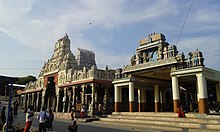Subramaniya Swamy Temple, Tiruchendur: Difference between revisions
Adding local short description: "Temple in Tamil Nadu, India", overriding Wikidata description "temple in India" (Shortdesc helper) |
Adding local short description: "Temple in Tamil Nadu, India", overriding Wikidata description "temple in India" (Shortdesc helper) |
||
| Line 1: | Line 1: | ||
{{Short description|Temple in Tamil Nadu, India}} |
|||
{{Short description|Temple in Tamil Nadu, India}} |
{{Short description|Temple in Tamil Nadu, India}} |
||
{{Use dmy dates|date=July 2018}} |
{{Use dmy dates|date=July 2018}} |
||
Revision as of 06:46, 29 May 2021
| Arulmigu Subramaniya Swamy Temple | |
|---|---|
அருள்மிகு சுப்பிரமணிய சுவாமி திருக்கோயில் | |
 View of the entrance | |
| Religion | |
| Affiliation | Hinduism |
| District | Thoothukudi |
| Deity | Subramaniya Swamy |
| Festivals | Vaikasi Visagam, Avani Festival, Skanda Sasti Festival and Masi Festival |
| Governing body | Tamil Nadu Hindu Religious and Charitable Endowments Department |
| Location | |
| Location | Tiruchendur |
| State | Tamil Nadu |
| Country | India |
| Geographic coordinates | 8°29′45″N 78°7′45″E / 8.49583°N 78.12917°E |
| Architecture | |
| Type | Tamil architecture |
| Website | |
| tiruchendurmurugantemple | |
Arulmigu Subramaniya Swamy Temple, Tiruchendur is an ancient Hindu temple dedicated to Lord Murugan. It is second among six abodes of lord Murugan (Arupadaiveedugal) situated in Tamil Nadu, India. The puranic name or historical name for this temple is Jayanthipuram. This temple is the fourth Hindu temple in Tamil Nadu to get ISO certification.[1] It is located in the eastern end of the town Tiruchendur in the district of Thoothukudi, Tamil Nadu, India. It is 40 km from Thoothukudi, 60 km south-east of Tirunelveli and 75 km north-east of Kanniyakumari. The temple complex is on the shores of Bay of Bengal. Temple is open from 5 AM to 9 PM
Arulmigu Subramaniya Swamy Temple, Tiruchendur is one of the six major abodes, or sacred temples, of the Kaumaram religion. Soorasamharam, a reenactment of the victory over Soorapadman, and Kanda Shasti, a devotional song in praise of Lord Murugan are performed at the temple.
Legend
Tiruchendur means sacred and beautiful town in Tamil. The temple is dedicated to Murugan, the warrior deity and second son of Shiva and parvati. When Murugan came here for the conquest along with his army, he found it to be very small and ordered the celestial architect Viswakarma to expand it. The town came to be know with several names like Tiruchendil, Jayanthipuram, Thiruchilavay and Srisandhinagaram. It is believed to be the place where Muruga conquered the demon Surapadma. After which he was named as Jayanthinathar(n) (meaning nathan - leader, jayanthi - victory, the victorious leader).It is believed that the demigods of Muruga wanted to worship him in a place where there was a mountainous tract, sea and river and hence Tiruchendur was chosen.There are 2 Utsava Murthis :- Jayanthi Nathar(He comes out almost everyday). Shanmukhar
(Comes out only during Maasi and Aavani Festival. Abhishekham for this lord happens only during this time
Vaippu Sthalam
It is one of the shrines of the Vaippu Sthalams sung by Tamil Saivite Nayanar Appar.[2][3]
Architecture
The temple, which is built near the seashore, measures 91 m (299 ft) north to south, 65 m (213 ft) east to west, and has a nine-tier gopuram, or tower gate, that is 157 feet (47 meter) high.[4] The principal entrance faces south, and opens into the first of two prakarams, the first of which is lined with rows of Yalis. The inner sanctum of the temple is in a cave and the main deity, or moolavar, is Murugan as a saintly child, portrayed in a granite carving.[5] Naazhi Kinaru, a sacred well fed by a freshwater spring, is located 100 m (330 ft) south of the temple. Devotees undergo a ritual cleansing by bathing in water from the well after bathing in the ocean.[5]
Dutch occupation of the Tiruchendur Temple

The Murugan temple at Tiruchendur was occupied by the Dutch East India company from 1646 to 1648, during the course of their war with the Portuguese. The local people tried to free their temple, with no success. The Dutch finally vacated the temple on orders from the Naik ruler. However, while leaving, they removed the idol of the 2 utsava murthis(This idol comes out only during Maasi and Aavani tirunal) made of an alloy named Shanmukhar , and took it with them. During their way in sea, they encountered a strong storm and realised their mistake of stealing the idol. They dropped the idol in the middle of the sea and seen the storm stopped immediately. Later, Lord Senthil Aandavan appeared in a dream to Vadamaliyappa Pillai, an ardent devotee of Murugan, and revealed the place in the sea where the idol had been abandoned. Vadamlaiyappa Pillai in the Tiruchendur temple, went to the spot in a fishing boat and retrieved the idol in 1653. The story is shown in paintings inside the temple.[6]
References
- ^ "ISO accreditation for Tiruchendur temple". The Hindu : NATIONAL / TAMIL NADU. Retrieved 4 December 2016.
- ^ மூவர் தேவார வைப்புத் தலங்கள், Muvar Thevara Vaippu Thalangal, செந்தில் (திருச்செந்தூர்) Senthil (Tiruchendur), 6-23-4
- ^ தேவார வைப்புத் தலங்கள், செந்தில், 6-23-4
- ^ Knapp, Stephen (1 January 2009). Spiritual India Handbook. Jaico Publishing House. pp. 387–. ISBN 978-81-8495-024-3.
- ^ a b Clothey, Fred W. (1978). The Many Faces of Murukan̲: The History and Meaning of a South Indian God. Walter de Gruyter. pp. 121–. ISBN 978-90-279-7632-1. Retrieved 5 September 2016.
- ^ Vink, Markus (2015). Encounters on the Opposite Coast: The Dutch East India Company and the Nayaka State of Madurai in the Seventeenth Century European Expansion and Indigenous Response. p. 347. ISBN 9789004272620.

